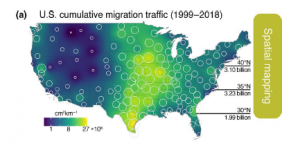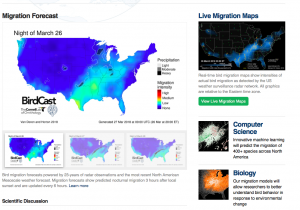News: Resources
A study published today in the journal Science reveals that the volume of spring migration, as measured by the NEXRAD radar network in the night skies, has dropped by 14 percent in the past decade. The paper further compiles bird survey data collected on the ground, indicating that bird populations in the United States and Canada have declined by 29 percent since 1970, representing a loss of almost 3 billion birds. Read more...
Welcome MistNet, a deep convolutional neural network to discriminate precipitation from biology in radar scans! MistNet is a tool that can enable large‐scale, long‐term, and reproducible measurements of whole migration systems, a hallmark of developments by our collaborators at University of Massachusetts and the BirdCast team. Read on to find out more about today's paper published describing this exciting new tool. Read more...
Special issue on Radar Aeroecology As you know, one of the main methods we use to study birds here at BirdCast is radar. Radar has been used to study animal movements for a long time, but recent advances has greatly increased its use and lead to a new wave of research and applications of radar […] Read more...
ANN ARBOR—Birds that produce faint chirps called flight calls during nighttime migration collide with illuminated buildings much more often than closely related species that don’t produce such calls, according to a new analysis of a 40-year record of thousands of building collisions in the Midwest. The new analysis of more than 70,000 nighttime songbird collisions in […] Read more...
Chicago, Houston, and Dallas top the list Ithaca, NY—An estimated 600 million birds die from building collisions every year in the United States. Scientists at the Cornell Lab of Ornithology have published new research highlighting artificial light at night as a contributing factor. They’ve ranked metropolitan areas where, due to a combination of light pollution and […] Read more...
Data from radar & bird watchers reveal spring migration details Ithaca, NY— A new study combining data from citizen scientists and weather radar stations is providing detailed insights into spring bird migration along the Gulf of Mexico and how these journeys may be affected by climate change. Findings on the timing, location, and intensity of these bird movements are published […] Read more...
New study finds both positive and negative impacts possible Ithaca, NY—Under future climate scenarios, changing winds may make it harder for North American birds to migrate southward in the autumn, but make it easier for them to come back north in the spring. Researchers from the Cornell Lab of Ornithology came to this conclusion using […] Read more...
4 Billion Birds Will Fly Through American Airspace This Fall By Carley Eschliman From the Autumn 2018 issue of Living Bird magazine. Subscribe now. Fall migration will bring 4 billion birds into the skies over the United States. That’s not a guess—it’s hard data, gleaned from the first-ever national bird count using weather radar. Cornell […] Read more...
Researchers predict the movements of millions of birds across the United States Ithaca, N.Y. & Oxford, U.K.—September is the peak of autumn bird migration, and billions of birds are winging their way south in dramatic pulses. A new study published in the journal Science reports that scientists can now reliably predict these waves of bird migration […] Read more...
Doppler weather radar data—like those shown in the animation above and often featured in weather broadcasts—can tell us much more than how much rain will fall on your weekend cookout. Here at BirdCast, we turn weather radar data into information on the numbers and flight directions of birds aloft in order to expand the understanding […] Read more...
FAQs: How does weather radar work? How do radar ornithologists remove ground clutter (nearby trees, buildings, and objects) from radar data? How do radar ornithologists remove weather systems from clouds of birds? Are there returns from aircraft on weather radar? Is all of the continental U.S. covered by radar? How is radar data converted into […] Read more...
Would you like more information on ways to use and to understand new BirdCast migration monitoring tools for spring 2018? Read on! Read more...
BirdCast has been working toward automatically predicting and analyzing bird migration across the continental US, and we now unveil automated forecast maps and live migration maps. Welcome to the future of migration monitoring, please explore the new visuals and tune in frequently for discussion about movements! Read more...
BirdCast Regions For migration forecasts and analyses, we use the following divisions to represent the continental US. We use these regions because their component states have many migration patterns in common and because their component states’ proximity make for logical groupings. Without doubt, finer scale delineation based on analyses of the details of migration patterns […] Read more...








